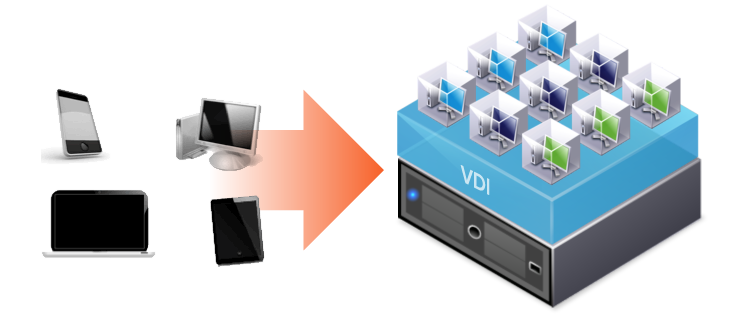Virtual desktop infrastructure (VDI)

In the presentation of Raul Coria, we were introduced to virtualization, and how such technology changed datacenters. One of those recent changes, he explained, was the virtualization of workspaces, and how that necessity created what is called the Virtual Desktop Infrastructure (VDI), which provides desktop as a service.
By itself, desktop virtualization is nothing else than a software technology that offers the capability of separating the desktop environment and its associated applications from the physical device itself. In other words, it is merely a type of virtualized environment, if of a higher level (Computer SO does not need to be virtualized, only desktop/interface).
That being said, this technology becomes interesting when we introduce Datacenters into the equation, allowing the implementation of VDI which, in layman’s terms, means that the desktop virtualization takes place in a datacenter. In this case, the end-device is merely used to receive the result (the streaming of data): computing and storage tasks are done in a remote location (datacenter).

This technology has many benefits in the business field:
First, it allows employees to work from any place whenever they want. Second, it reduces costs and increases efficiency, because the employees’ devices do not need to be powerful (these devices will not execute any program, they are thin clients). Third, the security is increased, because data is centralized. If someone gains access to one of the employees’ devices, he will not get any valuable information, as it does not store anything.
One example of how this technology can benefit a company is the case of a technological organization who reported savings of $54 million in the first year of integrating the virtual workplace concept into the organization.
This technology is not exclusive for workspace and can be used in a lot of different fields. In fact, nowadays, VDI structures also exist for things such as Cloud game streaming, enabling users to enjoy high-quality gaming through a low-end device (only a screen, a network card, and basic hardware and software are required).
However, although VDI has its benefits and useful implementations, it is not fully developed, and it has some drawbacks. One of the most important problems is about licensing because sometimes the software cannot be shared between devices or users.
Another problem or inconvenient is that this technology requires a network connection, which means that users cannot access their data, programs or services if they do not have one.